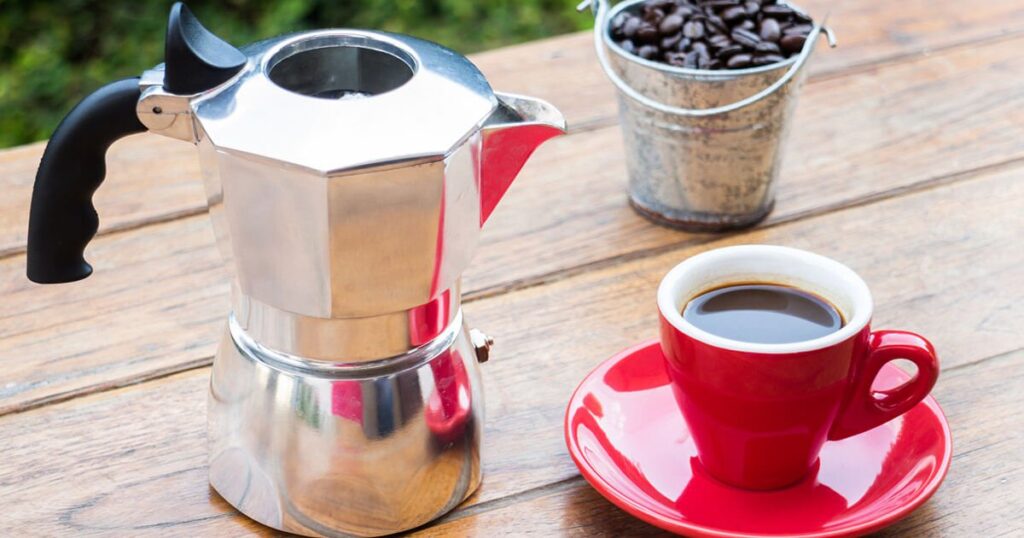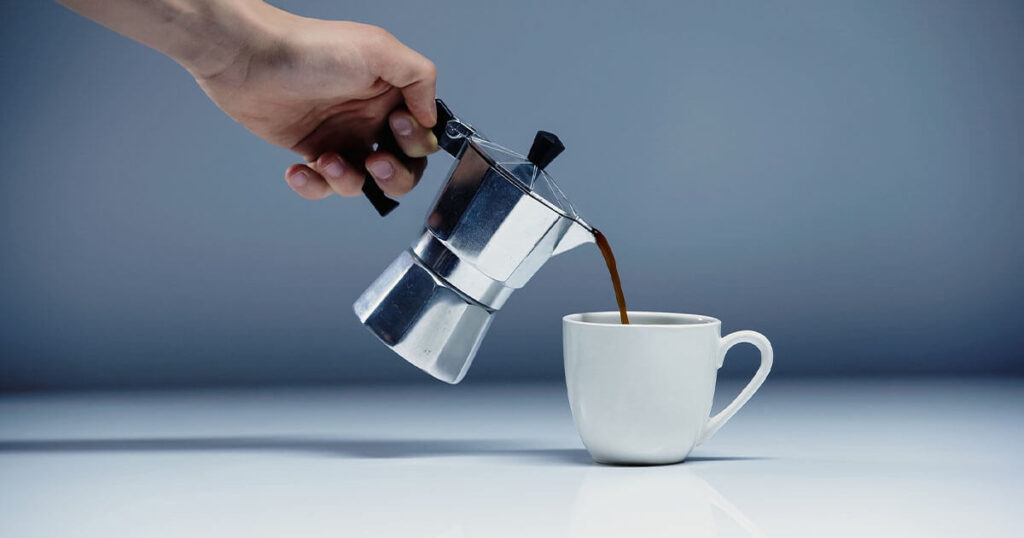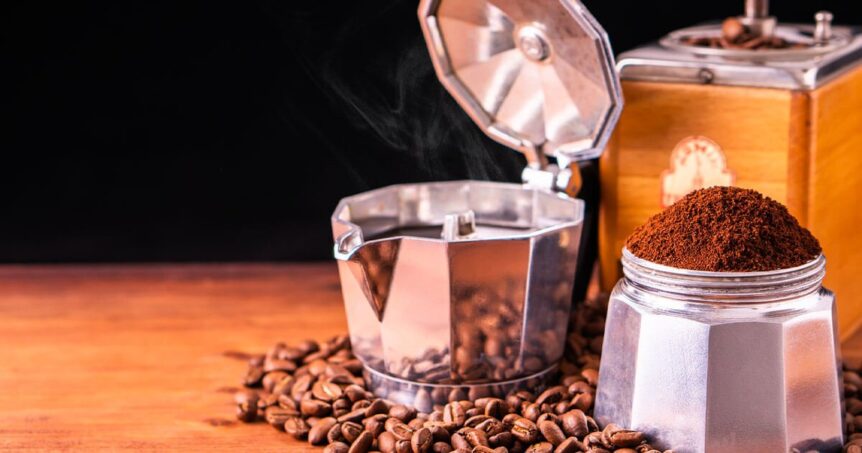The moka pot is a simple tool that makes some extraordinary coffee. By using pressurized water in a unique upside-down configuration it achieves a rich and intense extraction.
Discover the timeless art of brewing with the Moka Pot — an Italian classic and cherished method that consistently delivers rich, bold coffee. Moka pot is a tricky brewer, and messing up the process is very easy. But a good grasp of its fundamentals and careful preparation can make anyone an expert.
In this guide, we delve into Moka Pot’s history, brewing process, and nuances to give you a crash course on everything you need to know about Moka Pot coffee. Let’s dive head first into this interesting topic.
What is Moka Pot Coffee?
An ingenious Italian invention that has stood the test of time for nearly a century. The moka pot was specially designed to brew a rich, intense, and flavourful cup of joe.
It’s a specialized coffee brewer that uses a three-compartment design. A standard water container at the bottom, a coffee filter in the middle, and a brewed coffee collector at the top.
Boiling water in the bottom chamber gently evaporates, and the steam slowly rises to the top, making its way into the coffee filter. Those aromatic coffee grounds infuse the steam with a rich body and an intense flavor as it erupts from the top like a tiny volcano.
As the steam reaches the top container, it slowly condenses into a liquid, exits the top nozzle, and flows down it like a fragrant river of fresh hot coffee.
Moka pot coffee is the ideal middle ground between light drip coffee and concentrated espresso. Not too strong that it becomes bitter and not too weak that it dilutes the coffee taste. It really is a Goldilocks zone for most coffee lovers.
Thus, it should not be surprising that the Bialetti moka pot is present in over 70% of Italian households.
What is a Moka Pot Coffee Made Of?

Moka pot coffee is made of just two simple ingredients, quality coffee, and some hot water.
There is no restriction on the type of coffee beans you can use. In fact, you can use light or dark beans that are designed for an espresso machine.
However, you should be careful with your grind settings, Moka pots don’t like extra fine grounds. Your target should be somewhere between coarse espresso and fine aeropress.
The History of Moka Pot Coffee
A deep dive into the history of the Moka pot leads us down a fascinating rabbit hole. Many coffee historians point to a man named Luigi Di Ponti as the original inventor of the Moka Pot. Who, for reasons unknown, sold the patent to the then metal worker Alfonso Bialetti.
Bialetti, an industrious man, used his decade of aluminum industry know-how to mass produce the brewer under the name Moka Express Coffee Maker. The invention was first brought to the market in 1933, taking its name from the coffee hub of Yemen, the city of Mokha.
If Luigi was the real genius behind the moka pot, why is there so little evidence on the subject? Without solid proof, we can only make vague assumptions about the history of the moka pot. But as far as the modern world is concerned, Bialetti is the sole inventor of the now iconic coffee brewer.
However, Alfonso wasn’t able to market the Moka Pot successfully, and years later, his son Renato Bialetti, through sheer genius and passionate salesmanship, transformed it into an Italian classic. Renato passed away in 2016, and his ashes were placed in an urn shaped like a Moka Pot. A perfect ending to this caffeinated tale.
How Much Caffeine is in a Cup of Moka Pot Coffee?
Moka pot coffee packs approximately 162 mg of caffeine in a single cup, which is about 27 mg per ounce. Mind you, moka pot coffee doesn’t describe a beverage but a coffee preparation technique so in the end it all depends on the amount of coffee grounds, brewing time and extraction method.
How Many Calories Are in Moka Pot Coffee?
Accounting for the higher extraction of the moka pot, one cup (6 oz) of moka pot coffee contains approximately two calories. Moka coffee beverages using steamed milk or sweeteners will push the calorie content slightly higher.
Does Moka Pot make Espresso?
No. Despite being occasionally marketed as a stovetop espresso maker, the Moka pot can’t make espresso. Espresso requires over 115 psi of water pressure for a proper brew. The moka pot can only muster up to around 30 psi.
There is no such thing as a stovetop espresso maker. Don’t get taken in by dubious marketing claims.
Any attempt to make espresso in a moka pot using densely packed grounds will be in vain.
The bottom chamber will start to superheat as the steam pressure struggles to push the water through the coffee filter. The intense pressure will trigger the safety valve (moka valve), releasing the excess pressure from the base.
How to Make Moka Pot Coffee? 7 Easy Steps

The key to a good cup of coffee is preparation, especially when using a moka pot. Ensure your pot is clean, all the rubber seals are intact, and all ingredients are nearby.
Now let’s talk about making the perfect cup of moka pot coffee.
Step 1: Preheat Some Water
The secret to making good moka pot coffee is to preheat the water in a separate pot or kettle. Bring the water to a near boiling state and pour it into the moka pot.
Cold water takes more time to heat up, and in the process, your coffee gets toasted from the center and burnt at the edges resulting in unwanted bitterness.
Using already hot water in the moka will immediately start the brewing process, wetting the grounds in water vapor and preventing burning.
Step 2: Grind Your Coffee
While we wait for the water to heat up, let’s pick your favorite coffee beans and grind them to a medium-fine consistency.
A medium-fine consistency is generally a great option, it can bring some bitter notes in a dark roast. Thus a coarser grind for medium and dark roasts is generally a good solution.
Add 1 ½ – 2 tablespoons (~21gm) of ground coffee to the filter, and don’t press it, let it naturally fill the space.
Step 3: Pour the Hot Water into the Moka Base
By now, the water in the kettle should have reached the boiling point. Take it off the heat, or unplug it if you’re using an electric kettle, and fill the bottom chamber up to the pressure release valve.
The valve is a safety feature that will prevent excess pressure buildup in the chamber. You don’t want to underfill the pot, either. Go for at least 300 ml of water for one cup of coffee.
Step 4: Carefully and Tightly Close the Moka Pot
Next, you need to place the coffee filter between the bottom water chamber and the top collection chamber. Gently tighten the two halves together, ensuring a good seal.
The bottom half of the pot will be hot because of the water, use a kitchen towel to avoid direct skin contact.
Step 5: Set the Pot on a Stovetop
Finally, set your Moka on medium-low heat. It’s very easy to overheat a moka pot, especially when using a gas stove. Adding a frying pan or stainless steel plate to the bottom of the pot as a diffuse is a good idea.
Step 6: Brew Your Coffee
Now we wait. It should take around 3 minutes, depending on your desired coffee cup size. Keep a close eye and ear to the moka pot.
You want a nice smooth flow of liquid. Bubbling or sputtering sounds are an indication of a bad brew. It means your water is too hot, and the steam exits the top nozzle without properly infusing it with the coffee.
If you hear sputtering, place the pot off the heat on a wet kitchen towel or put the base under some running water. Excess heat will lead to a more bitter extraction.
Step 7: Enjoy Your Coffee Your Way.
Once you’re happy with the amount of brew, pour it into a cup and add optional ingredients like milk, foam, or sweeteners. Enjoy your liquid gold any way you like.
Moka Pot Coffee Recipe

Equipment
- Moka Pot Coffee Maker
- Coffee grinder
- Kettle
- Coffee Cup
- Kitchen Towel
Ingredients
- Medium Roast Coffee: 2 Tablespoons (½ ounce) of Medium-Fine Grind
- Water: 1 ½ Cups (360 ml)
Instructions
- Preheat the water in a kettle.
- Select medium-fine grind settings for your preferred beans.
- Loosely pack the filter with freshly ground coffee.
- Pour the preheated water into the bottom half below the safety valve.
- Place the coffee filter basket between the bottom chamber and the top collector.
- Using a kitchen towel to hold the base and slowly screw in the top half.
- Now the moka pot goes on the stove for 3 mins.
- Once you have extracted 6 ounces (178 ml), take the pot off the heat.
- Run the pot's base under cold water to stop the brewing process.
How to Clean a Moka Pot?
Moka pot is a very low-maintenance tool, as if coffee lovers needed another reason to fall in love with the wonderful moka.
- Rinse your moka pot quickly after you brew your coffee. Just a quick cold water wash, nothing more.
- Disassemble the moka and clean the rubber seals thoroughly.
- Dry the pot, the filter, and the rubber seals with a clean cloth and store them in a cool and dry space.
- Regular coffee drinkers will want to occasionally sanitize the pot. We recommend a once-a-week sanitization with a natural solution of vinegar, baking soda, and lemon juice.
- A well-maintained moka pot doesn’t need dishwashing soap to stay clean and shiny. However, we recommend cleaning the moka gently with soap and a soft sponge at least once a month.
Finally, a word of caution to moka owners. Don’t put your moka pot in the dishwasher. Moka pots, including the original Bialetti, are not dishwasher approved.
Additionally, if you are unsatisfied with the natural cleaning solution, you can just use soap for a weekly cleaning.
Coffee Beverages Made Using a Moka Pot

Moka pot coffee is a good espresso replacement for those looking for a mellow but still rich coffee flavor. Here is a short list of our favorite Moka coffee beverages.
Classic Black
You can’t go wrong with the tried and true black coffee. Moka coffee is smooth and has no sharp aftertaste associated with espresso. Black is a great way to enjoy all the natural flavors and aromas of the coffee beans.
Macchiato
A simple moka macchiato involves a 1-2 ounces of freshly brewed coffee topped with fluffy white milk foam. The foam acts as a gentle cushion for the rich punch of the coffee drink.
Latte
Latte is, in many ways, the ideal way to enjoy milk coffee. A full body of moka coffee tempered by a nice and warm embrace of steamed whole milk.
Americano
Another classic way to enjoy intense, rich moka coffee is to dilute it with a bit of water and make it an americano. You want at least two ounces of coffee and, at most, four ounces of hot water.
Iced Coffee
While some like it hot, others prefer a cold cup of coffee. Grab a tall glass, add six ounces of room temp moka coffee, and three ice cubes. Replace three ounces of coffee with milk for a chilled latte.
Frequently Asked Questions
What Kind of Coffee Do You Use in a Moka Pot?
You can use anything from light to dark roast and a medium-fine to medium grind consistency. A grind size slightly closer to fine espresso is also compatible with the moka pot.
What Makes Moka Pot Coffee Better?
The pressurized water in a moka pot can extract more flavors from the coffee without dipping into the bitter aftertaste resulting in a stronger, more flavor-rich brew compared to drip and pour-over coffee.
Is a Cup of Moka Pot Coffee Stronger Than Regular Coffee?
Absolutely! Even the weakest moka pot coffee will have three times the caffeine content of regular drip coffee. It also has a more full and complex body than regular coffee.
Is Moka Coffee as Strong as a Shot of Espresso?
No. Moka coffee has less than half of the strength of an espresso shot. But it does come close to the punch of espresso better than any other coffee. Moka coffee is close enough to espresso shots that you can use it as a replacement for your lattes and macchiatos.
Can I Use any Ground Coffee in My Moka Pot?
You can't use very fine ground coffee in a moka pot. Otherwise, the water will be unable to pass through the filter. Moka pots support everything from medium-fine ground coffee to coarse coffee. Although you will start to lose flavor as you go for coarser ground.
What is the Difference Between Moka Coffee and Espresso?
A cup of moka coffee is brewed in a Moka Pot at 15-30 psi (1-2 bars) and has a serving size of 6 oz. In contrast, a shot of espresso is only 2 oz and brewed at 115-145 psi (8-10 bars). It requires a special espresso machine capable of handling such high pressures. Flavor-wise, espresso is more concentrated, richer, and more intense than the rich and well-rounded moka pot coffee.
Is Moka Pot Coffee Healthy?
Moka coffee is as healthy as other types of coffee. It packs the same amount of caffeine as a regular cup of joe but has more than two times the caffeine. A six oz serving of moka coffee has 162 mg of caffeine, well under the 400 mg threshold recommended by doctors.
Why Does My Moka Pot Coffee Taste Bitter?
Bitterness in moka pot coffee arises from over-extraction of the grounds. You can avoid this by brewing the coffee at a gentle medium-low heat. Afterward, run some cold water on the base of the pot to halt the brewing process.
Can You Drink Straight Black Moka Pot Coffee?
Of course, many enjoy the complex taste of moka coffee and avoid adding milk or creamers. Moka also has a softer impact on the back of your throat than rich espresso.
Do You Add Milk to Moka Pot Coffee?
Milk is an optional ingredient in moka coffee. Adding some milk turns it into a milk coffee, and adding some steamed milk and a bit of foam turns it into a latte.
Do You Put Boiling Water in a Moka?
No. You want near-boiling water around 160°F, which will help brew coffee quickly. Cold water takes longer to reach the desired temperature, and you can burn the coffee grounds during that time.
Is Moka Pot a Type of Percolator?
While the moka pot shares similarities to a percolator, it's a distinctly different brewer. The percolator constantly cycles the water through the grounds. In contrast, the Moka pot makes one pressurized water pass through the grounds.
Which is Better: Moka Pot or French Press?
Moka pot uses pressure to brew the coffee compared to the French press' steeping method. You get a sharper and stronger brew with the Moka and a more well-rounded body with the French press.
Both methods are easy to use, but the moka pot requires more attention.
Final Thoughts
Hey, you made it through this entire article! We dove right into the wonderful world of moka pot coffee and learned so many things.
Congratulations, you are now fully informed on the interesting history of the moka pot, its capabilities, its brewing process, and the brewing versatility it offers to coffee drinkers around the world.
Coffee is very personal, and the moka pot lets us fine-tune its taste, strength, and temperature to our liking.
Enjoy your coffee your own way using a moka pot.

